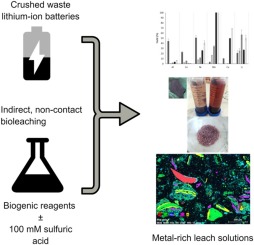Journal of Hazardous Materials ( IF 12.2 ) Pub Date : 2018-08-16 , DOI: 10.1016/j.jhazmat.2018.08.024 Naomi J. Boxall , Ka Yu Cheng , Warren Bruckard , Anna H. Kaksonen

|
Applying biohydrometallurgy for metal extraction and recovery from mixed and polymetallic wastes such as electronic waste is limited due to microbial inhibition at low pulp densities and substrate (iron and sulfur) limitation. Here, we investigated the application of indirect non-contact bioleaching with biogenic ferric iron and sulfuric acid to extract metals from lithium-ion battery (LIB) waste. Results showed that although a single leach stage at ambient temperature only facilitated low leach yields (<10 %), leach yields for all metals improved with multiple sequential leach stages (4 × 1 h). Biogenic ferric leaching augmented with 100 mM H2SO4 further enabled the highest leach yields (53.2 % cobalt, 60.0 % lithium, 48.7 % nickel, 81.8 % manganese, 74.4 % copper). The proposed use of bioreagents is a viable and a more environmentally benign alternative to traditional mineral processing, which could be further improved by appropriate pre-treatment of the LIB waste.
中文翻译:

间接非接触式生物浸出在废旧锂离子电池中提取金属的应用
由于在低纸浆密度和底物(铁和硫)限制下的微生物抑制作用,限制了生物湿法冶金技术从混合废料和多金属废料(例如电子废料)中提取和回收金属的能力。在这里,我们研究了生物铁酸铁和硫酸间接非接触式生物浸出从锂离子电池(LIB)废料中提取金属的应用。结果表明,尽管在环境温度下一个浸出阶段仅会促进较低的浸出率(<10%),但所有金属的浸出率却随着多个连续的浸出阶段(4×1 h)而提高。100 mM H 2 SO 4增强生物铁浸出进一步实现了最高的浸出率(53.2%的钴,60.0%的锂,48.7%的镍,81.8%的锰,74.4%的铜)。提议的生物试剂的使用是传统矿物加工的可行且对环境更温和的替代方法,可以通过对LIB废物进行适当的预处理来进一步改善。











































 京公网安备 11010802027423号
京公网安备 11010802027423号